ADVERTISEMENT
It is a measure of the company’s performance and a method used to evaluate its performance without regard to financial, accounting or tax decisions. ( EBITDA – Earnings Before Interest, Tax, Depreciation and Amortization) is calculated by adding non-cash depreciation and amortization expenses to a company’s operating income.
EBITDA account
The EBITDA equation can be represented in the following form: the profits achieved by the company before adding interest and deducting the value of taxes, then adding the value of depreciation and amortization of debt. and debt amortization.
When reducing the non-operating effects specific to each company or organization, EBITDA earnings allow investors to focus on operating profit as a measure of performance. This analysis is important when comparing the performance of companies in a specific sector or companies that are subject to different tax brackets.
Difference between EBIT and EBITDA
EBIT represents the approximate amount of operating income generated by a business, while EBITDA is the cash flow generated by a company’s operations. EBITDA shows the results of operations on an accrual basis, while EBITDA shows an approximation of the cash flows generated from operations.
ADVERTISEMENT
EBITDA is often used to improve a company’s valuation for acquisitions because these valuations are usually based on cash flows. This indicator is often used in the analysis of capital intensive firms or companies that consume large amounts of intangible assets; otherwise, depreciation or debt amortization expenses can overwhelm the company’s net income, which indicates the occurrence of large losses.
The value of any EBITDA is not normally permitted to be included in the income statement under GAAP. Instead, they are calculated separately because they are not part of a company’s financial statements. They are often used by an external analyst who wants to review the company’s past performance.

EBITDA model
The EBITDA model is used as a metric to assess the operating performance and financial health of a company, excluding some other financial considerations such as debt repayment, depreciation methods, taxes, and others. The model also helps the company and analysts make comparisons between companies, predict the company’s long-term profitability, and measure its ability to pay its future obligations. Download the EBITDA form.
Read also: The relationship between profitability and liquidity



